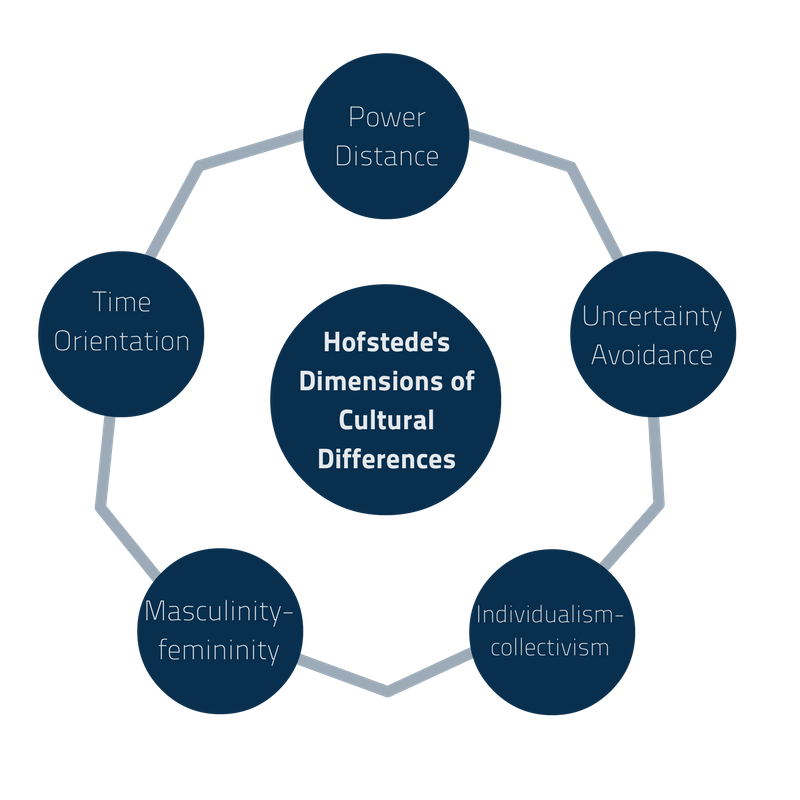mobvet
Understanding cultural background
We all have cultural values, ways of communicating, customs, different attitudes to time management, eating and dressing habits. The aim of this topic is to explore and understand how cultural values might underlie different patterns of behavior.
According Dutch scientist Hofstede, “Culture is the collective programming of the mind that distinguishes the members of one group or category of people from others”. Most commonly, the term “culture” is used for ethnic groups (in anthropology), for nations (in political science, sociology and management), and for organizations (in sociology and management). A relatively unexplored field is the culture of occupations (for instance, of engineers versus accountants, or of academics from different disciplines). The term can also be applied to the genders, to generations, to social classes, etc (Hofstede, 2011).

Source: Hofstede, G. (2011). Dimensionalizing cultures: The Hofstede model in context. Online Readings in Psychology and Culture, 2 (1).
Hofstede describes five dimensions of national cultural differences which help to rise individuals awareness of their own cultural baggage and provide them with knowledge about other cultures
1. Power distance, related to the different solutions to the basic problem of human inequality;
2. Uncertainty avoidance, related to the level of stress in a society in the face of an unknown future;
3. Individualism versus collectivism, related to the integration of individuals into primary groups;
4. Masculinity versus femininity, related to the division of emotional roles between women and men;
5. Long term versus short term orientation, related to the choice of focus for people’s efforts: the future or the past and present.

Assignment:

Each country has been positioned relative to other countries through a score on each dimension. This tool will help you to prepare yourself before mobility. It will give you insights about your “own culture” in comparison to your host culture.
This dimension indicates how people deal with differences in power and human inequality.
What is characteristic to the culture with high power distance?
High power distance means that people have less problems in accepting inequality, social status and hierarchy. People are (relatively) dependent on the power holder. This could result in subordinates not taking own initiative, but rather wait for the boss to give instructions. There is also relatively little real empowerment. Hierarchy is existential – it’s there, and that’s good and normal. Typically there are privileges for the people in power. Personal privileges and favors are counted on and accepted. Countries with cultures that have high power distance are: China, Mexico, France, Belgium, The Arab World.

How high power distance appears in education?
- Teachers have high prestige. What they say should be accepted, so students tend not to discuss or question what they are taught.
- Teachers are treated with respect (and older teachers even more than younger teachers).
- The educational process is teacher centered.
- In the classroom there is supposed to be a strict order, with the teacher initiating all communication. Students in class speak up only when invited.
- Teachers are never publicly contradicted or criticized and are treated with defense even outside school.
- When a student misbehaves, teachers involve parents and expect them to help in disciplining the student.
- Teachers are a gurus who transfer personal wisdom.
- Quality of learning depends on excellence of teachers.
- High expectations on benefits of technology.
What is characteristic to the culture with low power distance?

Low power distance means that people prefer more democratic behaviour, and inequality is kept to minimum if possible. People are (relatively) independent of the power holder (parents, teacher, boss, etc). When there are, so called, hierarchical layers, there must be a good reason for this. Putting a management layer, or manager in place just like that, will not easily be accepted. Equality is the key – “if you are allowed to do this, then I’m allowed to do the same as well”. In this culture people accept open door policy – this could literally mean that the door of the manager is open, or that the relationships in the organization are not formal. Countries with low power distance cultures are Austria, Denmark, Sweden, Finland, UK, Norway.
How low power distance appears in education?
- Teachers are supposed to treat their students as equals and expect to be treated as equals by the students.
- The education process is student centered, with a premium on student initiative.
- Students argue with teachers, express disagreement and criticisms in front of teachers.
- Students are supposed to ask questions when they do not understand something
- The entire system is based on the student’s well developed need for independence.
- The quality of learning depends on two-way communication and excellence of students.
- Modest expectations on benefits of technology.
Key differences between high and low power distance in the workplace
|
High power distance |
Low power distance |
|
Centralized decision structures, more concentration on authority |
Decentralized decision structures, less concentration on authority |
|
Tall organization pyramids |
Flat organization pyramids |
|
Large proportion of supervisory personnel |
Small proportion of supervisory personnel |
|
The ideal boss is a well-meaning autocrat or good father, sees self as decision maker |
The ideal boss is a resourceful democrat, sees self as practical, orderly, and relying on support |
|
Managers rely on formal rules |
Managers rely on personal experience and on subordinates |
|
Subordinates expect to be told |
Subordinates expect to be consulted |
|
Innovations need good support from hierarchy |
Innovations need good champions |
|
Privileges and status symbols for managers are expected and popular |
Privileges and status symbols for managers are frowned upon |
|
Wide salary range between top and bottom of organization |
Narrow salary range between top and bottom of organization |
|
Frequent role ambiguity and overload |
Possibilities to escape from role ambiguity and overload |
|
Information constrained by hierarchy |
Openness with information |
Source: Hofstede, G. (2001). Culture’s consequences: comparing values, behaviors, institutions and organizations across nations, 107-108.
This dimension indicates how people confront with unknown and unexpected events and life changes. It shows the extent to which a culture programs its members to feel either uncomfortable or comfortable in unstructured situations. Unstructured situations are novel, unknown, surprising, and different from usual.
What is characteristic to the culture with high level of uncertainty avoidance?

Uncertainty avoiding cultures try to minimize the possibility of unstructured situations by strict laws and rules, safety and security measures. For example, in Germany there is a reasonable high uncertainty avoidance (65). Germans are not to keen on uncertainty, by planning everything carefully they try to avoid the uncertainty. This is a society that relies on rules, laws and regulations. Germany wants to reduce its risks to the minimum and proceed with changes step by step. Countries with high scores of uncertainty avoidance are also: Greece, Portugal, Japan, France, Austria.
How high level of uncertainty avoidance appears in education?
- Both teachers and students favor structured learning situations with precise objectives, detailed assignments and strict timetables.
- Teachers are expected to know all answers.
- Teachers who use cryptic academic language are respected.
- Intellectual disagreement in academic mattes is interpreted as personal disloyalty.
- Students attribute achievement to effort and luck.
- Traditional role models for female students.
What is characteristic to the culture with low level of uncertainty avoidance?
In cultures with low level of uncertainty avoidance, uncertainty is accepted as natural. There will be a positive attitude towards flexibility, chaos and differences. In class situations this translates into pragmatism. The teacher can publicly admit not knowing all the answers without losing status or prestige. Students can handle new and informal teaching methods with greater ease. Countries with low scores are: UK, Denmark, Sweden, Ireland.
How low level of uncertainty avoidance appears in education?
- Students expect open-ended learning situations with broad assignments, good discussions, and no timetables at all.
- Students expect to be rewarded for originality.
- Teachers may say: „I do not know.“
- Students learn that truth may be relative.
- Students attribute achievements to own ability.
- Dialect speech is positively valued.
- Independence for female students is important.
Key differences between high and low uncertainty avoidance in the workplace
|
High uncertainty avoidance |
Low uncertainty avoidance |
|
Conservatism, law and order. Only known risks are taken. |
Openness to change and innovation. Willingness to take unknown risks. |
|
What is different is dangerous. Xenophobia. |
What is different, is curious. Tolerance of diversity. |
|
Fear of failure. Preference for tasks with sure outcomes, no risks and following instructions. |
Hope of success. Preference for tasks with uncertain outcomes, calculated risks and requiring problem solving. |
|
Strong loyalty to employer, long average duration of employment |
Weak loyalty to employer, short average duration of employment |
|
Preference for larger organizations but at the same time much self-employment |
Preference for smaller organizations but little self-employment |
|
Strong appeal of technological solutions. |
Skepticism toward technological solutions |
|
Innovators feel constrained by rules |
Innovators feel independent by rules |
|
Top managers involved in operations |
Top managers involved in strategy |
|
Appeal of hierarchical control role. |
Appeal of transformational control role. |
|
Few new trademarks granted |
Many new trademarks granted |
|
Innovations resisted but, if accepted, applied consistently |
Innovations welcomed but not necessarily taken seriously |
|
Precision and punctuality come naturally |
Precision and punctuality have to be learned and managed |
|
Task orientation |
Relationship orientation |
|
Flexible working hours popular |
Flexible working hours not appealing |
|
Belief in specialists and expertise |
Belief in generalists and common sense |
Source: Hofstede, G. (2001). Culture’s consequences: comparing values, behaviors, institutions and organizations across nations, 169 -170.
This dimension demonstrates the degree to which people in a society are integrated into groups.
What is characteristic to the individualistic culture?

Individualistic cultures are those that stress the needs of the individual over the needs of the group as a whole. In this type of culture, people are seen as independent and autonomous. Social behavior tends to be dictated by the attitudes and preferences of individuals. Cultures in North America and Western Europe tend to be individualistic. High individualism scores are for example in UK, Netherlands, Ireland, Belgium, Denmark.
How individualism appears in education?
- Individual initiatives of students expected and respected
- Purpose of education is learning how to learn
- Students associate according to tasks and current needs
- Learning is seen as life-long process
- Students selves to be respected
- Students expected to speak up in class or large groups
- Students self-esteem good for academic performance
- Diplomas increase economic worth and self-respect.
What is characteristic to the collectivist culture?

People from a collectivist culture place more value on the interests of the group they belong to, than on the interests of individual. They derive their personal identity from the group (family, village, work unit, student group etc.). They think in terms if „we“ and give priority to good relationships. This will be their first concern in the classroom as well. Diplomas and degrees are important because they make it easier for a person to increase their social status. Collectivist cultures outnumber individualistic ones, particularly in Asia and Africa, the cultures with specially high scores in collectivism are: Guatemala, China, Venezuela, Pakistan.
How collectivist culture appears in education?
- Teachers deal with students as a group
- Pupils individual initiatives discouraged
- Purpose of education is learning how to do
- Learning is seen as one-time process, reserved for the young only
- Students associate according to preexisting in-group ties
- Harmony in class: confrontations to be avoided
- Students will not speak up in class or large groups
- Students aggressive behaviour bad for academic performance
- Diplomas provide entry to higher-status groups.
Key differences between collectivist and individualist culture in the workplace
|
Collectivist |
Individualist |
|
Hiring and promotion decisions take employees in-group account |
Hiring and promotion decisions should be based on skills and rules only |
|
Relatives of employer and employees preferred in hiring |
Family relationships seen as a disadvantage in hiring |
|
Employee commitment to organization low |
Employee commitment to organization high |
|
Employees perform best in groups |
Employees perform best as individuals |
|
Training most effective when focused at group level |
Training most effective when focused at individual level |
|
Relationships with colleagues cooperative for in-group members, hostile for out-group |
Relationships with colleagues do not depend on their group identity |
|
In business, personal relationships prevail over task and company |
In business, task and company prevail over personal relationships |
|
Belief in collective decisions |
Belief in individual decisions |
|
Innovations within existing networks |
Innovations outside existing networks |
|
Employees and managers report teamwork |
Employees and managers report working individually |
|
Less control over job and working conditions; fewer hours worked |
More control over job and working conditions; longer hours worked |
|
Less social mobility across occupations |
Greater social mobility across occupations |
Source: Hofstede, G. (2001). Culture’s consequences: comparing values, behaviors, institutions and organizations across nations, 244.
Cultures can be also classified according to the way social roles are assigned.
What is characteristic to the masculine culture ?

If more value is given to role patterns ordinarily associated with men, the culture is masculine. For example, competition and ambition are considered to be masculine traits. In education people from masculine cultures will strive for recognition, good grades and are not afraid to fight for what they want. The cultures of Japan, Italy, Hungary, Slovakia are with high masculine index.
How masculine culture appears in education?
- Students’ performance is important
- Students try to make themselves visible in class and compete in terms of academic achievement
- Competitive sports play an important role in curriculum
- Public praise to reward good students
- Best student is a norm
- Failing in school is a disaster
- Job (and curriculum) choices by students are strongly guided by perceived career expectations
- Young children taught by women only
- Boys and girls study different subjects
- Large difference in perceptual ability: boys analytic, girls contextual.
What is characteristic to the feminine culture ?

Modesty and caring are seen as feminine values. People from more feminine cultures tend to seek harmony, consensus, compromises and equality. At the feminine end of the scale are Scandinavian countries, the Netherlands.
How feminine culture appears in education?
- Students’ social adaptation is important
- Excellence is something one keeps to oneself, being over-ambitious is not encouraged
- Competitive sports are extracurricular and not part of the school’s main activities
- Public praise to encourage weak students
- Average student is a norm
- Failing in school is a relatively minor incident
- Job (and curriculum) choices by students are guided by intrinsic interest
- Young children taught by men and women
- Boys and girls study same subjects
- Small gender difference in perceptual abilities.
Key differences between feminine and masculine societies: the workplace
|
Feminine |
Masculine |
|
Work in order to live. Meaning of work for workers: relations and working conditions |
Live in order to work. Meaning of work for workers: security and pay |
|
Stress on equality, solidarity and quality of work life |
Stress on equity, mutual competition and performance |
|
Managers expected to use intuition, deal with feelings, and seek consensus |
Managers expected to be decisive, firm, assertive, aggressive, competitive |
|
Successful managers seen as having both male and female characteristics |
Successful managers seen as having solely male characteristics |
|
More women in management, smaller wage gap between genders |
Fewer women in management, larger wage gap between genders |
|
Women choose female boss |
Women choose male boss |
|
Career ambitions are optional for both men and women |
Career ambitions are compulsory for men, optional for women |
|
Women in management take having families for granted and adapt their careers |
Women in management take having career for granted and adapt their families |
|
Job applicants undersell themselves |
Job applicants oversell themselves |
|
Resolution of conflicts through problem solving, compromise and negotiation |
Resolution of conflicts through denying them or fighting until the best „man“ wins |
|
More sickness absence |
Less sickness absence |
|
Lower job stress: fewer burnout symptoms among employees |
Higher job stress: more burnout symptoms among employees |
|
Preference for smaller companies |
Preference for larger companies |
|
Preference for fewer hours worked |
Preference for higher pay |
Source: Hofstede, G. (2001). Culture’s consequences: comparing values, behaviors, institutions and organizations across nations, 318.
This dimension indicates the extent to which society prefers a pragmatic, more future-oriented perspective over a historical and short-term perspective.
What is characteristic to the culture of long term orientation?

Long-term orientation stands for the fostering in a society of pragmatic virtues oriented to future rewards, in particular perseverance, thrift, and adapting to changing circumstances. Efforts and good coping at school are an investment for future to get a good job, be successful, healthy and happy. Cultures with long term orientation are: Japan, South-Korea, Germany, Belgium, Estonia.
How long term orientation appears in education?
- Interest in the distant future, pragmatism, innovation.
- Readiness to get “reward” for the effort in the future.
- Students are more persistent in their activities.
- Students perform well at problem solving tests (PISA etc)
What is characteristic to the culture of short term orientation?
Short term orientation, stands for the fostering in a society of virtues related to the past and the present, such as national pride, respect for tradition, preservation of face, and fulfilling social obligations.The main focus is on today’s relationships and activities, an excessive respect for tradition, lack the tendency to save for the future, and focus on quick results. Cultures with short term orientation are: Egypt, Lebanon, Ghana, Syria, etc.
How short term orientation appears in education?
- Students care more about immediate gratification/reward than long-term fulfillment
- Learning is more often seen as a one-time process which occurs mainly in the classroom, and studying out-of-class is neglected
- Interest in the past, present / nearest future
- Students are more inconsistent in their activities and easily discarded.
Key differences between short term and long term orientation in social life and workplace
|
Short term orientation |
Long term orientation |
|
Quick results expected, in business – short time results |
Persistence, in business – building relationships and market position |
|
Meritocracy: economic and social life to be ordered by abilities |
People should live more equally |
|
Personal steadiness and stability |
Personal adaptability |
|
Respect for traditions |
Adaptation of traditions to new circumstances |
|
Leisure time is important |
Leisure time is not important |
|
Most important events in life occur in past or in present |
Most important events in life will occur in future |
|
Small share of additional income saved |
Large share of additional income saved |
|
Investment in mutual funds |
Investment in real estate |
Source: Hofstede, G. (2001). Culture’s consequences: comparing values, behaviors, institutions and organizations across nations, 360 – 366.


